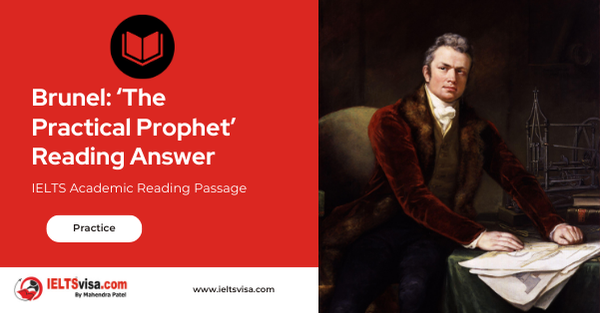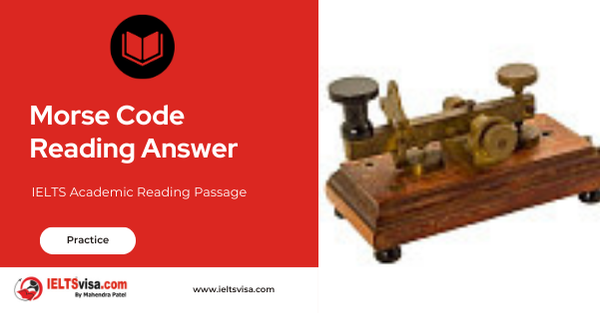Brunel: ‘The Practical Prophet’ Reading Answer
IELTS Academic Reading Passage
A. In the frontispiece of his book on Brunel, Peter Hay quotes from Nicholson’s British Encyclopaedia of 1909 as follows: ‘Engineers are extremely necessary for these purposes; wherefore it is requisite that, besides being ingenious, they should be brave in proportion.’ His father, Sir Marc Isambard Brunel (1769-1849), was himself a famous engineer, of French parents. He eventually settled in Britain and married the Sophia Kingdom, an English woman whom he had known in France in earlier days. Their only son Isambard was born on 9 April 1806. He was sent to France at the age of 14 to study mathematics and science and was 16 when he returned to England to work with his father. Sir Marc was then building his famous tunnel under the River Thames. Isambard was recuperating near Bristol from injuries received in a tunnel cave-in when he became involved with his own first major project.
The Suspension Bridge ion the Avon Gorge B
The span of Brunel’s bridge was over 700ft, longer than any existing when it was designed, and the height above water about 245ft. The technical challenges of this engineering project were immense, and Brunel dealt with them with his usual, thoroughness and ingenuity. Two design competitions were held, and the great bridge designer Thomas Telford was the committee’s expert. Brunel presented four designs. He went beyond technicalities to include arguments based on, among other things, the grace of his tower design. Unfortunately, he only got so far as to put up the end piers in his lifetime. The Clifton Suspension Bridge was completed in his honor by his engineering friends in1864 and is still in use.
The Great Western Railway C
While Brunel was still in Bristol, and with the Avon Bridge project stopped or going slowly, he became aware that the civic authorities saw the need for a railway link to London.
Railway location was controversial since private landowners and towns had to be dealt with. Mainly, the landed gentry did not want a messy, noisy railway anywhere near them. The Duke of Wellington (of Waterloo fame) was certainly against it. Again Brunel showed great skill in presenting his arguments to the various committees and individuals. BruneI built his railway with a broad gauge (7ft) instead of the standard 4ft 8½in, which had been used for lines already installed. There is no doubt that the broad gauge gave superior ride and stability, but it was fighting a standard.
Atmospheric railway:
D
Brunel’s ready acceptance of new ideas overpowered good engineering judgment (at least in hindsight) when he advocated the installation of an atmospheric railway in South Devon.
It had the great attraction of doing away with the locomotive and potentially could deal with steeper gradients. Since this connecting arm had to run along the slit, it had to be opened through a flap as the train progressed, but closed airtight behind it. Materials were not up to it, and this arrangement was troublesome and expensive to keep in repair. After a year of frustration, the system was abandoned. Brunel admitted his failure and took responsibility. He also took no fee for his work, setting a good professional example.
Brunel’s ships:
E
The idea of using steam to power ships to cross the ocean appealed to Brunel. When his GWR company directors complained about the great length of their railway (it was only about 100 miles), Isambard jokingly suggested that they could even make it longer—why not go all the way to New York and call the link the Great Western. The “Great Western” was the first steamship to engage in transatlantic service. Brunel formed the Great Western Steamship Company and construction started on the ship in Bristol in 1836. Built of wood and 236ft long, the Great Western was launched in 1837 and powered by sail and paddlewheels. The first trip to New York took just 15 days, and 14 days to return. This was a great success, a one way trip under sail would take more than a month. The Great Western was the firsts steamship to engage in transatlantic service and made 74 crossings to New York.
F
Having done so well with the Great Western, Brunel immediately got to work on an even bigger ship. Great Britain was made of iron and also built-in Bristol, 322ft in length. The initial design was for the ship to be driven by paddle wheels, but Brunel had seen one of the first propeller-driven ships to arrive in Britain, and he abandoned his plans for paddlewheel propulsion. The ship was launched in 1843 and was the first screw-driven iron ship to cross the Atlantic. Great Britain ran aground early in its career but was repaired, sold, and sailed for years to Australia, and other parts of the world, setting the standard for ocean travel. In the early 1970s, the old ship was rescued from the Falklands and is now under restoration in Bristol.
G
Conventional wisdom in Brunel’s day was that steamships could not carry enough coal to make long ocean voyages. But he correctly figured out that this was a case where size mattered. He set out to design the biggest ship ever, five times larger than any ship built up to that time. Big enough to carry fuel to get to Australia without refueling, in addition, it would carry 4,000 passengers.
The Great Eastern was 692ft long, with a displacement of about 32,000 tons. Construction began in 1854 on the Thames at Millwall. Brunel had chosen John Scott Russell to build the ship. He was a well-established engineer and naval architect, but the contract did not go well. Among other things, Scott Russell was very low in his estimates and money was soon a problem. Construction came to a standstill in 1856 and Brunel himself had to take over the work. But Brunel was nothing if not determined and by September 1859, after a delayed and problem -ridden launch, the Great Eastern was ready for the maiden voyage, Brunei was too sick to go, but it was just as well because only a few hours out there was an explosion in the engine room which would have destroyed a lesser ship. Brunel died within
a week or so of the accident. The great ship never carried 4,000 passengers (among other things, the Suez Canal came along) and although it made several transatlantic crossings, it was not a financial success. Shortly after the Great Eastern began working life, the American entrepreneur Cyrus Field and his backers were looking for a ship big enough to carry 5,000 tons of telegraphic cable, which was to be laid on the ocean floor from Ireland to Newfoundland. Although Brunel did not have it in mind, the Great Eastern was an excellent vessel for this work on July 27, 1866. It successfully completed the connection and a hundred years of transatlantic communication by cable began. The ship continued this career for several years, used for laying cables in many parts of the world.
Questions 1-6
Use the information in the passage to match the project Brunel did (listed A-G) with opinions or deeds below.
Write the appropriate letters A-G, in boxes 1-6 on your answer sheet.
A.River Thames Tunnel
B.CliftE.on Suspension Bridge
C.Atmospheric Railway
D.Great Britain
E.The Great Western
F.Great Western Railway
G.The Great Eastern
1. The project of construction that I.K.Brunel was not responsible
2.The project had stopped due to inconvenience and high maintaining
3.The project was honored to yet not completed by Brunel
4.The project had a budget problem although built by a famous
5.Serious problem happened and delayed
6.The first one to cross the Atlantic Ocean in mankind
Questions 7-9
The reading Passage has seven paragraphs A-G. Which paragraph contains the following information?
Write the correct letter A-G, in boxes 7-9 on your answer sheet
NB You may use any letter more than once.
7.There was a great ship setting the criteria for the journey of the
8.An ambitious project which seemed to be applied in an unplanned service later.
9.Brunel showed his talent of inter-personal skills with landlords and finally, the project had been gone through.
Questions 10-13
Complete the following summary of the paragraphs of Reading Passage
Using NO MORE THAN TWO WORDS from the Reading Passage for each answer.
Write your answers in boxes 10-13 on your answer sheet.
The Great Eastern was specially designed with a 10………………. for carrying more fuels
and was to take a long voyage to 11……………… ; However due to physical condition,
Brunel couldn’t be able to go with the maiden voyage. Actually, the Great Eastern was unprofitable and the great ship never crossed 12………….. But soon after there was an
ironic opportunity for the Great Eastern which was used to carry and to lay huge 13……………… in Atlantic Ocean floor.

Solution:Brunel: ‘The Practical Prophet’ Reading Answer
| 1. valley | 8. TRUE |
| 2. miners | 9. NOT GIVEN |
| 3. 20 percent | 10. NOT GIVEN |
| 4. electricity | 11. FALSE |
| 5. copper | 12. FALSE |
| 6. sand | 13. TRUE |
| 7. zinc |
Review and Practice
- Regularly practice with IELTS reading samples and time yourself to get used to the pressure of the exam.
- Review your mistakes to understand where you went wrong and how to avoid similar errors in the future.
Our Books
Master IELTS Speaking Part 1
IELTS Writing Task 1 Book
IELTS Writing Task 2 Book
Brunel: ‘The Practical Prophet’ Reading Answer Explanation
Comin Soon
Practice IELTS Other Modules
IELTS Listening
The IELTS Listening test assesses how well you can understand spoken English in various contexts. It lasts about 30 minutes and is divided into four sections with a total of 40 questions. The listening tasks become increasingly difficult as the test progresses.
IELTS Academic Reading
The IELTS Academic Reading section assesses your ability to understand and interpret a variety of texts in academic settings. It is designed to evaluate a range of reading skills, including skimming for gist, reading for main ideas, reading for detail, understanding inferences, and recognizing a writer's opinions and arguments.
IELTS Speaking
The IELTS Speaking test assesses your ability to communicate in English on everyday topics. It lasts 11-14 minutes and consists of three parts: introduction, cue card, and a discussion based on the cue card topic.
IELTS General Reading
IELTS General Reading tests your ability to understand and interpret various types of texts. Here are some key areas and types of content you can expect to encounter in the reading section, along with tips for effective preparation.
IELTS Academic Writing Task 1
In IELTS Academic Writing Task 1, you are presented with a visual representation of information, such as graphs, charts, tables, or diagrams, and you are required to summarize, compare, or explain the data in your own words.
IELTS General Writing Task 1
In IELTS General Writing Task 1, you are required to write a letter based on a given situation. The letter can be formal, semi-formal, or informal, depending on the prompt. Here’s a breakdown of the key components to include in your letter
IELTS Academic Writing Task 2
In IELTS Academic Writing Task 2, you are required to write an essay in response to a question or topic. Here’s a guide to help you understand the essential elements of this task
IELTS Exam Tips
To succeed in the IELTS exam, practice regularly, familiarize yourself with the test format, improve your vocabulary, develop time management skills, and take mock tests to build confidence.
Grammer for IELTS
Grammar is the foundation of effective communication in English. Understanding tense usage, subject-verb agreement, and sentence structure enhances clarity and coherence in writing and speaking.
Vocabulary for IELTS
Vocabulary plays a crucial role in the IELTS (International English Language Testing System) exam, especially in the Speaking and Writing sections. Here’s an overview of why vocabulary is important and how it impacts your performance
RECENT IELTS SAMPLES QUESTIONS AND ANSWERS
Becoming An Expert Reading Answer
A Expertise is commitment coupled with creativity. Specifically, it is the commitment of...
STUDY CENTRE COURSES Reading Answer
SELF-STUDY TIPS AHowever difficult you find it to arrange your time, it will pay off in the...
The Extrinct Grass In Britain Reading Answer
A The British grass interrupted brome was said to be extinct, just like the Dodo. Called...
Morse Code Reading Answer
A. A new satellite-based system is being implemented to replace Morse code for sending...
Magnetic Therapy Reading Answer
AMagnetic therapy, which is a $5-billion market worldwide, is a form of alternative medicine...
Lack Of Sleep Reading Answer
Section A It is estimated that the average man or woman needs between seven-and-a-half and...













